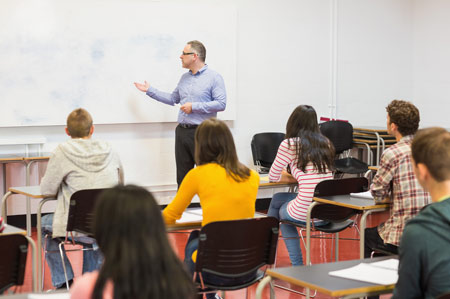- Didattica

Semestre filtro
Corsi di laurea
Corsi di laurea magistrale
POST LAUREA
- Facoltà
- Segreterie e sedi

Segreterie
Strutture
- Persone
- MY UNIVR
-
To show the organization of the course that includes this module, follow this link  Course organization
Course organization
The aims concern two groups of lectures
In the first group of lectures, we will illustrate the fundamental concepts of bioenergetics of muscle contraction. In particular, the metabolic pathways of muscle ATP production will be illustrated from a quantitative point of view, assigning to each of them the values of maximum power and maximum capacity that they are able to express.
In the second group, we will discuss the cardiovascular responses to dynamic and isometric exercise. In particular, the responses of heart rate, stroke volume, cardiac output, arteriovenous difference, redistribution of cardiac output with particular attention to resetting the baroreflex will be illustrated.
After studying this chapter, the student should be able to:
1. List and describe the nutrients that are used as energy substrates during exercise.
2. Describe the structure of ATP and its cellular function.
3. Discuss the metabolic pathways involved in the anaerobic production of ATP.
4. Describe the aerobic production of ATP.
5. Describe how bioenergetic metabolic pathways are regulated.
6. Discuss the interaction between aerobic and anaerobic production of ATP during exercise.
7. Identify the enzymes that limit the flow of substrates in glycolysis and in the citric acid cycle.
8. Understand the meaning of maximum alactacid anaerobic power and the principles behind its determination
Group 1
Essential background
Biochemistry of energy metabolism (aerobic and anaerobic glycolysis, oxidative phosphorylation, concepts of exoergonic and endoergonic reactions, free energy); anatomy and histology of skeletal muscle
Topics
1. The approach to the study of muscle bioenergetics in vivo in humans;
2. Oxidative processes in the light of muscle bioenergetics;
3. Steady-state oxygen consumption (applications, efficiency concept);
4. The maximum oxygen consumption;
5. The deficit (or contracted debt of O2);
6. Regulation of oxidative metabolism
7. Lactate during submaximal exercise
8. The lactate concentration and exercise intensity
9. The lactate concentration and duration of exercise-MLSS
10. Production speed and lactate disposal speed
11. The concept of the lactate quill
12. The lactate membrane carriers
13. The energy balance of an exercise performed with a stable high lactate concentration
14. Identification of the "anaerobic" threshold
15. Lactate during the supramaximal exercise and the energy equivalent of lactate
16. Maximum power and alactacid anaerobic capacity (meaning and measurement methods)
Group 2
Essential background
Physiology and anatomy of the cardiovascular system
Topics
1. The determinants of maximum oxygen consumption according to Fick's equation
2. Stroke volume, heart rate and cardiac output during muscle exercise
3. Determinants of stroke volume during muscle exercise
4. The arteriovenous difference of oxygen during the exercise
5. Blood pressure responses during the dynamic exercise
6. Redistribution of cardiac output during exercise
7. Functional vasodilation of muscle vessels; sympatholysis
8. The permissive meaning of the resetting of the baroceptive reflex
9. Control of cardiovascular responses during exercise (central command, metaboreflex)
| Reference books | |||||
| Author | Title | Publisher | Year | ISBN | Note |
| Guido Ferretti, Carlo Capelli | DAGLI ABISSI ALLO SPAZIO Ambienti e limiti umani (Edizione 1) | edi-ermes | 2008 | 978-88-7051-312-7 | |
| di Prampero | La locomozione umana su terra, in acqua, in aria | Edi Ermes | 2015 | ||
| Powers SP & Howley E | Physiology of the exercise: Theory and Application to Fitness and Performance | Mc Graw-Hill Education | 2012 | 978-0-078-02253-1 | Tra poco sarà anche disponibile la traduzione in italiano a cura della casa editrice PICCIN, Padova, I |
The exam will consist of an oral interview on the topics covered during the lectures. The exam will last about 20-30 minutes.
© 2002 - 2025
Verona University
Via dell'Artigliere 8, 37129 Verona |
P. I.V.A. 01541040232 |
C. FISCALE 93009870234